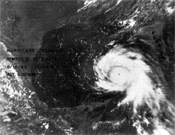|
Home > Weather > Hurricanes
What is a Hurricane?
A hurricane is a very powerful type of cyclonic storm. The name "hurricane" is given to storm systems that develop over the Atlantic or the eastern Pacific Oceans. These same types of extreme, cyclonic storms also occur in other oceans of the world, but are called by other names. In the northwest Pacific they're called typhoons, and most of the rest of the world they are called cyclones. They all have one thing in common; wind speeds that are usually greater than 75mph, which travel in an organized pattern, usually a circular pattern with a central depression around which the storms' energy circulates (called the 'eye of the storm'). These types of storms develop over warm, tropical oceans, deriving their energy from the evaporation of sea water. Hurricanes weaken as they move over land because they rely on the warm seas to supply their tremendous energy through evaporation. Land also has a rougher surface than the ocean (due to changes in elevation and surface topography). When the winds of a hurricane meet with friction from the land surface the storm loses its power and ferocity. The wind speeds that classify a hurricane don't typically lose their intensity until they move inland. For those who've made their homes along the coastline, a hurricane moving towards shore poses a tremendous danger. These extreme storms pack a heck of a punch when they first make landfall, threatening the very fabric and foundation of civilization.
Hurricanes are weather events that tend to occur seasonally, during the warm weather of later summer and early fall. "Hurricane season" runs from June to early November, when the tropical seas are at their warmest. Scientists and meterologists use a special scale, called the Saffir Simpson Hurricane Intensity Scale, to rate the strength of a hurricane they are watching. This rating can be useful to people living in areas threatened by an incoming hurricane to help them prepare for the onslaught.
Some Infamous Storms:
 Hurricane Camille Hurricane Camille
August, 1969
Sustained wind speeds; 190 mph
Rating:
Category 5
Damage: USD $6.1 billion
Hardest Hit: Mississippi, Lousiana, Virginia/USA
Satellite image of Camille, 1969
(Photo courtesy of NOAA)
Hurricane Andrew
August, 1992
Sustained wind speeds; 145 mph/gusts up to 175 mph
Rating:
Category 4
Damage: an estimated USD $26 billion
Hardest Hit: South Florida, US
|

